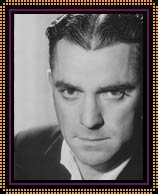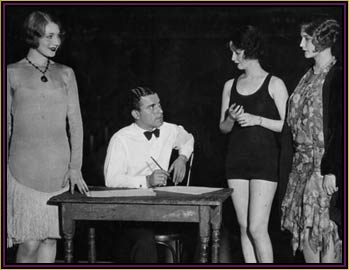 A producer, director, author, dancer, and actor, White’s first taste of show business came in his teens when he formed a burlesque dancing team with Ben (or Benny) Ryan. Later, he had generally modest solo roles in shows such as “The Echo” (1910), “Ziegfeld Follies,” “The Whirl of Society,” “The Pleasure Seekers,” “The Midnight Girl,” and “Miss 1917,” which had music mainly by the young Jerome Kern. In 1919, he produced and directed the first of a series of revues, George White’s “Scandals,” which combined the best of America’s own burgeoning popular music (as opposed to the imported European variety) with fast-moving sketches and glamorous women. The shows were similar to, although perhaps not quite so lavish, as the undisputed leader of the genre, the “Ziegfeld Follies.” The “Scandals” appeared annually until 1926, and that edition, the longest runner of them all with 424 performances, was particularly notable for its score by DeSylva, Brown, and Henderson, which introduced several enduring numbers such as “Lucky Day,” “Black Bottom,” and “Birth of the Blues.”
A producer, director, author, dancer, and actor, White’s first taste of show business came in his teens when he formed a burlesque dancing team with Ben (or Benny) Ryan. Later, he had generally modest solo roles in shows such as “The Echo” (1910), “Ziegfeld Follies,” “The Whirl of Society,” “The Pleasure Seekers,” “The Midnight Girl,” and “Miss 1917,” which had music mainly by the young Jerome Kern. In 1919, he produced and directed the first of a series of revues, George White’s “Scandals,” which combined the best of America’s own burgeoning popular music (as opposed to the imported European variety) with fast-moving sketches and glamorous women. The shows were similar to, although perhaps not quite so lavish, as the undisputed leader of the genre, the “Ziegfeld Follies.” The “Scandals” appeared annually until 1926, and that edition, the longest runner of them all with 424 performances, was particularly notable for its score by DeSylva, Brown, and Henderson, which introduced several enduring numbers such as “Lucky Day,” “Black Bottom,” and “Birth of the Blues.”

White auditioning dancers for his revues, the "Scandals."
There was no George White “Scandals” in 1927, but there was a show about the “Scandals” entitled “Manhattan Mary,” which ran for a decent 264 performances. White produced it and also co-wrote the book with Billy K. Wells. It too had songs by DeSylva, Brown, and Henderson, which included “The Five-Step” and “It Won’t Be Long Now,” and starred White himself and the highly popular zany comedian Ed Wynn. The “Scandals” proper resumed in 1928, and there were further editions in 1929 and 1931. In the latter show, the future movie star, Alice Faye, appeared in the chorus, and this time the songs were by Lew Brown and Ray Henderson (DeSylva had gone to work in Hollywood). Ethel Merman introduced the lovely “Life Is Just a Bowl of Cherries” and “Ladies and Gentlemen, That’s Love,” as well as duetting with Rudy Vallee on “My Song.” Vallee also sang “The Thrill Is Gone” (with Everett Marshall) and “This Is the Missus” (with Peggy Moseley). George White’s “Music Hall Varieties” replaced the “Scandals” in 1932, and in the cast was another Hollywood star of the future, tap-dancer supreme Eleanor Powell, and the likeable song-and-dance man (among other things) Harry Richman, who introduced Herman Hupfield’s delightful ballad, “Let’s Put out the Lights and Go to Sleep.”
George White
- "The Echo"
- "Flying High"
- "George White's Scandals"
- "Manhattan Mary"
- "Melody"
- "Runnin' Wild"
- Ray Bolger
- George Gershwin
- Ira Gershwin
- Jerome Kern
- Bert Lahr
- Ethel Merman
- Florenz Ziegfeld
Source: Biographical information provided by MUZE. Excerpted from the ENCYCLOPEDIA OF POPULAR MUSIC, edited by Colin Larkin. © 2004 MUZE UK Ltd.
Photo credits: Photofest and Culver Pictures

